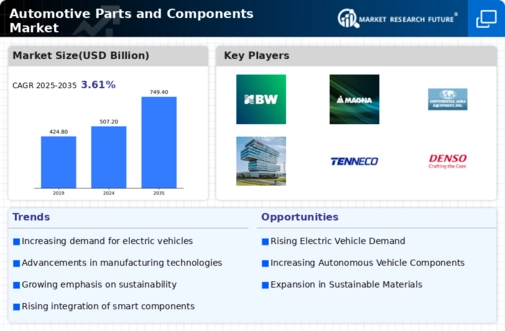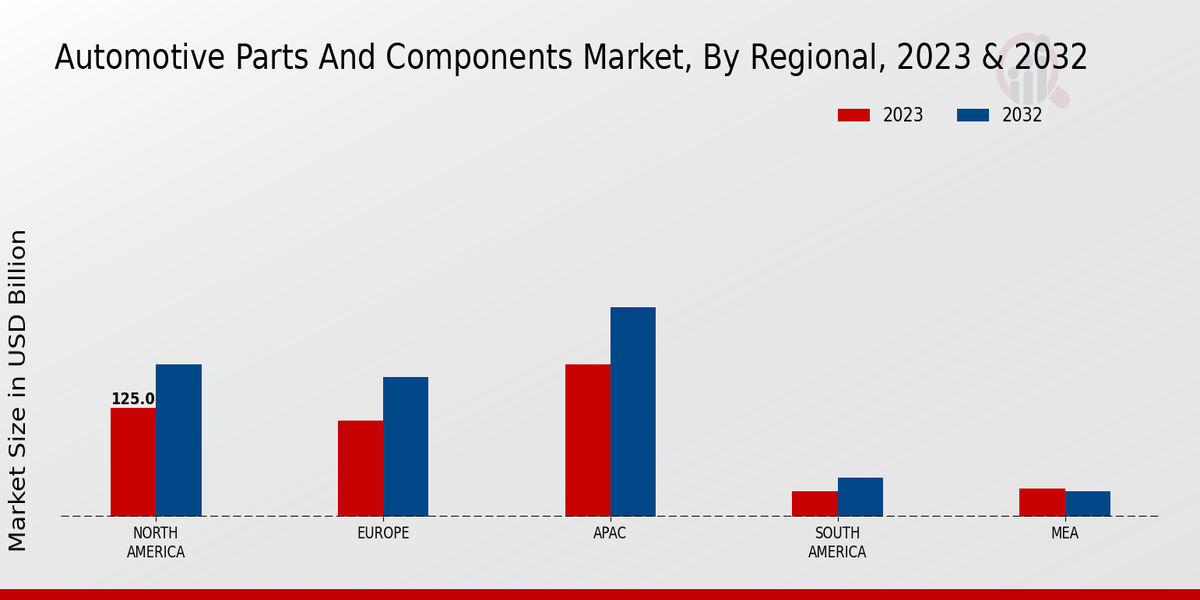Market Growth Projections
The Global Automotive Parts and Components Market Industry is projected to experience steady growth, with a compound annual growth rate (CAGR) of 3.61% anticipated from 2025 to 2035. This growth trajectory suggests a robust demand for automotive components, driven by factors such as increasing vehicle production, technological advancements, and a growing aftermarket segment. As the market evolves, it is likely to reach a valuation of approximately 749.4 USD Billion by 2035. This projection highlights the potential for investment and innovation within the industry, indicating a promising future for automotive parts and components.
Rising Vehicle Production
The Global Automotive Parts and Components Market Industry is experiencing growth driven by the increasing production of vehicles worldwide. In 2024, the market is valued at approximately 507.2 USD Billion, reflecting a robust demand for automotive parts. Countries such as China and India are leading in vehicle manufacturing, contributing significantly to this trend. As production ramps up, the need for various components, including engines, transmissions, and electronic systems, escalates. This surge in vehicle production not only boosts the market for automotive parts but also encourages innovation in component manufacturing, thereby enhancing overall market dynamics.
Sustainability Initiatives
Sustainability initiatives are increasingly influencing the Global Automotive Parts and Components Market Industry. As environmental concerns rise, manufacturers are focusing on producing eco-friendly components and materials. This shift towards sustainability is likely to drive innovation in the development of lightweight materials and recyclable parts. Governments worldwide are implementing stricter regulations regarding emissions and waste management, prompting manufacturers to adapt their practices. This trend not only aligns with global sustainability goals but also presents opportunities for growth in the market, as consumers increasingly prefer vehicles that incorporate sustainable technologies and components.
Technological Advancements
Technological advancements play a pivotal role in shaping the Global Automotive Parts and Components Market Industry. The integration of smart technologies, such as advanced driver-assistance systems (ADAS) and electric vehicle components, is transforming the landscape. As manufacturers adopt cutting-edge technologies, the demand for high-tech components is likely to rise. For instance, the shift towards electric vehicles necessitates specialized parts, which could lead to a significant market expansion. This trend indicates a potential for growth, as the industry adapts to evolving consumer preferences and regulatory requirements, ultimately enhancing the market's value.
Growing Aftermarket Segment
The aftermarket segment within the Global Automotive Parts and Components Market Industry is expanding rapidly, driven by increasing vehicle ownership and the need for maintenance and repairs. As more vehicles are on the road, the demand for replacement parts, accessories, and upgrades is likely to rise. This segment is projected to grow significantly, as consumers seek quality components to enhance vehicle performance and longevity. The aftermarket is expected to contribute substantially to the overall market, with estimates suggesting that it will account for a considerable share of the 2035 market value of 749.4 USD Billion, reflecting the importance of this segment in the automotive ecosystem.
Regulatory Compliance and Safety Standards
Regulatory compliance and safety standards are critical drivers in the Global Automotive Parts and Components Market Industry. Governments are enforcing stringent regulations to enhance vehicle safety and reduce emissions, compelling manufacturers to invest in high-quality components. Compliance with these regulations often necessitates the adoption of advanced technologies and materials, which can increase production costs but also improve vehicle performance and safety. As a result, manufacturers are likely to prioritize the development of compliant parts, which could lead to a more competitive market landscape. This focus on safety and compliance is expected to shape the future of the automotive parts industry.













